I will be out of town the next couple of weeks. It will be a reluctant break from my soapmaking mania, but I am excited to be in Honolulu for the Hawaii Food and Wine Festival and to be visiting my sister in California after. Yipee!!!
Before I take off, here’s a tutorial on lye master batching.
LYE MASTER BATCHING, 1:1 ratio or 50% concentration
1. You will need:
- 2 liters distilled water
- 2 kilos sodium hydroxide/NaOH/caustic soda (pearls or flakes)
- 1 chemical-resistant plastic container* that can hold 1 gallon or minimum 3 kilos
- 1 large bowl or basin that can hold the plastic container
- 1 digital weighing scale
- 1 pair gloves
- 1 pair safety goggles
- 1 long chemical-resistant stirring spoon
*To learn more about what’s safe to use, you may want to check out this forum thread. Avoid metal containers as you run the risk of turning your lye solution gray, and always have a container with a bigger capacity than what’s going into it.
2. Although you can mix the solution in the kitchen with the exhaust turned-on, I prefer to do it outside for better ventilation as the fumes are very biting and strong. Just for added precaution so that the lye solution does not overheat, I always place the mixing container in a bowl filled with cold tap water (think nuclear reactor). With safety gear in place, it’s time to pour the NaOH into the container with distilled water.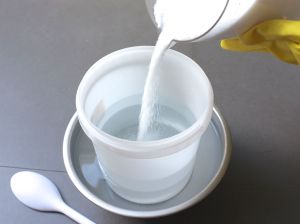
3. Cover your nose (I just hold my breath) and stir until the NaOH has been completely dissolved.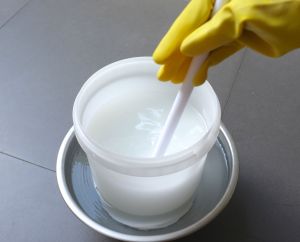
4. Cover the container loosely to prevent debris from going in and to prevent rapid evaporation. If I make the lye solution before going to work, I transfer it to a bathroom that no one uses. By the the time I come home, it would have cooled down already. Alternately, this can be done at night and left to cool down overnight.
Right after mixing, the solution gets very very hot, near boiling. Look at the water bubbles forming from the heat:
5. When the solution has completely cooled down, give it a good stir. I also like to strain it before it goes into the jug. Make sure to clearly and properly mark your container and store in a place where no one will accidentally bump into it or mistake it for something else. (I store it under the kitchen sink)
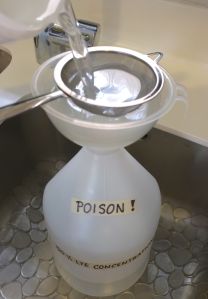 The net weight of the solution is 4 kilos or 8.8 pounds, but since the solution is very dense, its volume is approximately a little over half a gallon.
The net weight of the solution is 4 kilos or 8.8 pounds, but since the solution is very dense, its volume is approximately a little over half a gallon.
HOW TO USE 50/50 MASTER-BATCHED LYE IN YOUR RECIPE
To avoid confusion, I will be using the term lye pre-mix to mean master-batched lye solution and NaOH to mean DRY lye or caustic soda.Let’s take an example and assume these were the numbers shown after running your recipe through a lye calculator:
Water 265 grams NaOH 130 grams
→ Multiply the called for NaOH by 2:
130 g. NaOH x 2 = 260 g. lye pre-mix
→Subtract NaOH weight from water amount (lye calculator amounts):
265 g. water – 130 g. NaOH = 135 g. additional liquid
(Explanation: Remember our lye pre-mix is half water, half NaOH. Thus, to determine how much pre-mix to use, we have to double the NaOH quantity called for in the recipe. Correspondingly, we have to deduct the water in the pre-mix from the total liquid required to know how much more to add.)
In a nutshell:
A recipe that calls for 130 grams NaOH and 265 grams water would need:
260 g. lye pre-mix + 135 g. water
To double check that your conversion is correct, the sum of the numbers of the original recipe should be the same as for the pre-mix:
Original recipe: 265 g. water + 130 g. NaOH = 395 g.
Recipe with pre-mix: 135 g. water + 260 g. lye pre-mix = 395 g.
Note: Mixing the lye pre-mix with additional water or any form of liquid will cause the whole thing to heat up again! Unless you actually prefer to have it hot to melt hard oils or for whatever reason, I suggest mixing your water/milk/juice directly into the oils, then adding in the lye pre-mix after.
I hope my tutorial was clear and didn’t make you more confused 🙂 . For additional information, there are several forum threads out there, just google “lye master batching.” I would also highly recommend reading Kevin M. Dunn’s Scientific Soapmaking. From his book, I learned it was possible to have a 50% lye concentration, and even though it does not talk about master batching, it helped me to understand lye and water percentages/discounts and just about all the nerdy stuff behind soap making. (Ok, there was a lot of hard core chemistry and equations that I skipped. I only read portions that interested me 🙂 )
I don’t master batch my oils because I like playing with different recipes, but I can’t imagine going back to weighing and mixing lye every time I have to make soap. I just love the ease and convenience, and in my opinion, it’s really no more dangerous than having to dissolve solid NaOH every time. Needless to say, extra precaution has to be taken when dealing with any hazardous substance.
When I need to use some lye pre-mix, I just pour directly from the jug. I don’t even shake it because I think the the NaOH has dissolved and bound completely with the water. But that’s just me. I guess there’s no harm in shaking it up a bit before using, if that makes you feel better.
Happy soaping! 🙂

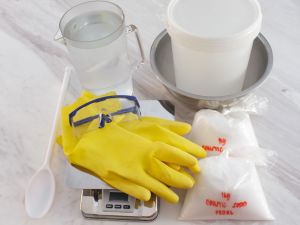
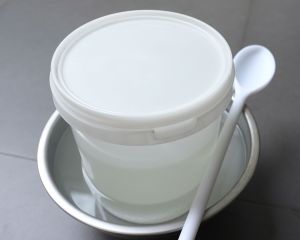
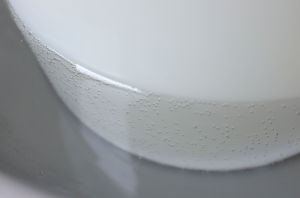
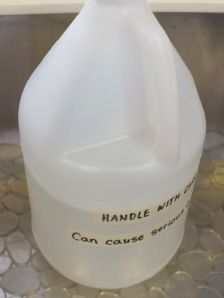
This is a very good idea, but my first thoughts was were could I store lye water safely. I live in a quite small apartment with hubby, a large dog and a rabbit. Now I have the dry lye stored in a bottle on a high shelf behind two doors (and behind several non toxic bottles) so the dog do not get it.
Thank you so much for taking the time to put together this tutorial Silvia, I would definitely love to try this if I can figure out how to store it safely. Hope you have a wonderful time in Hawaii enjoying all that food and sunshine, and have a great visit with your sister!
Ooh jealous of your trip! Hope you have a super duper time Silvia!
Thank you so much for this tutorial, it’s making me want to try making CP soaps more than ever. The only problem is that I’m so frickin’ lazy, I need to organize my MP soap supplies before thinking of bringing in even more stuff. But at least when I do start to seriously consider CP soaps, I’ll know where to find a good starting point.
Marika and Cee: True, storage could be a problem. I also have a dog in the house, so I store my jug of lye solution in the cabinet under the kitchen sink, together with empty jars and household cleaning stuff. What about putting the jug in another tightly sealed container with huge warning labels?
Monica: I thought of making soap for months before I got my act together and once I did, I was hooked! I know you will get there soon. You already make intricate M&P. Looking forward to seeing your creations!
I was just thinking about lye masterbatching this morning as I measured lye out. I have always found it confusing but your tutorial is quite clear…now I just have to muster up the courage to take on the task. Enjoy your time away, even thought you wont be soapmaking I bet you come home with tons of inspiration. Safe travels. 🙂
Hi Stacie! I am happy to hear that you found the tutorial clear. I also had to muster up the courage to do it. I think I was more nervous making soap and dealing with lye the first time.
I am excited to hit the craft stores, meet celebrity chefs (hopefully!) and have a good dose of good eats! And yes, come home inspired. Thank you so much, Stacie!
Finaly found the reply-button. I was looking at the bottom of your post. Thanks for this post! I’m making a master batch too, will save a lot of time.
Thanks so much for this – I’m still at the ‘one batch at a time’ stage, but have been thinking about masterbatching for a while – this post will be really helpful when I finally decide to do it :0)
Have an amazing vacation!
Vicki
Thanks for sharing this tutorial, Silvia! I’ve never tried lye master batching, but I can see where it would be handy, especially for larger-scale production. I tend to make small batches every now and then and just make the lye solution as needed. Have a great trip! I lived near Honolulu for about four months nearly ten years ago, and it was beautiful. And I’ve always wanted to visit California.
Pingback: The Truth About Lye: The Basics | Suburban Mountain Man
Pingback: Job’s Tears and Calendula Soaps | SoapJam
Really enjoyed reading your blog and good luck in all your future soaping ventures!
I master batched my lye from the beginning too. I was soaping for a couple of years before I discovered that most soapers don’t, but like you, I don’t mater batch my oils since I often tinker with the percentages(ie, I might increase the olive oil content from 30% to 40% – 50% if I’m doing a lot of colors to give me more time to mix them before the soap thickens).
Keep up the good work…your soaps are beautiful!
Thank you and welcome to my blog, Evelyn!
I just started following you. I am always excited to discover soapy blogs! 🙂
I don’t know how I missed your reply to my comment…must have been with all the craziness of getting out Christmas orders. 🙂
I referenced this blog post in my latest behind the scenes post.
Thanks!
Heather
Pingback: How Do You Do That??? Part 2 | evelynrosesoaps
Pingback: Custom Stamp Giveaway: Share a Soaping Tip or Trick | SoapJam
Silvia:
I know this is about an old blog, but I’ve been reading all your past postings and just got to the lye master batching. How cool! I’ve never read about this.
I’m still making small batches, and I soap at warmer temps – usually 120-130 F (49-54 C) I have never soaped at room temperature. I noticed a comment in the instructions that said to add the rest of your liquids into your oils, if you add it to the lye mix it will heat up again. Have you done this or know how hot it would heat up to?
Thank you for your expertise….still learning here!!
Best,
The other Sylvia
From one Silvia to another Sylvia: 🙂
I also started making soap at warmer temps (because that’s what the book said), but now I never soap above 95˚F, except only when I am using beeswax.
The first time I made soap using masterbatched lye, I added the rest of the liquids into the lye solution, which quickly became hot. I did not take the temperature, but my guess is that it was around 120-130˚F. After that, I always added the rest of the liquids to the oils as I prefer soaping at cooler temps. It also minimizes the risk of early trace and overheating, especially for milks and fruit purees.
Your soaps are beautiful! I recently discovered your blog and have been reading each and every post. I really appreciate this tutorial on lye master batching. It has made it very easy for me to understand the calculations. Thank you so much for sharing!
Regards,
Tina G.
Little Critters Farm
You are most welcome, Tina. 🙂 I am happy to hear that the tutorial has been of help.
Hi there, thanks for this guide. What I’m wondering is if anyone takes into account the purity of the lye. For instance if I have 97% pure lye flakes vs. 99% pure beads, that would throw off the calculations. Moreso, only one lye calculator I have seen (Brambleberry) actually states their calculator is based off of 97%. I’ve read that the variance won’t make a difference (probably because of SAP values being averages/estimations,) but If I’m going to go through the trouble of measuring to .1 grams, I’d like to be as precise as possible.
Any insight would be greatly appreciated.
Hi Nic. When I started out, it used to bug me that I could not get precise values for SAP and lye purity. Unfortunately, there’s no way for us to have perfect accuracy unless we have every item lab-tested like large manufacturers do. Superfatting allows us some margin for error. For soaps, I go by 1 gram increments. It’s only for lotions and other skin care products that I would use .1 gram increments. All I can say is that soapmaking at home will never be perfectly precise but we can still make great products and have fun. 🙂
Fantastic tutorial, thank you so much, finally I understood it:)) Have a nice weekend. I am fun of your soaps :))
Hi Danuta! I’m happy to hear you found the tutorial useful. Happy soaping! 😊